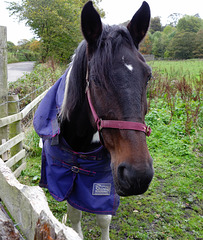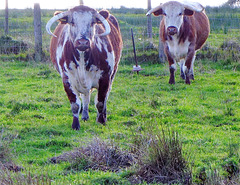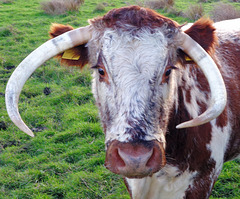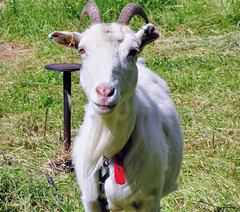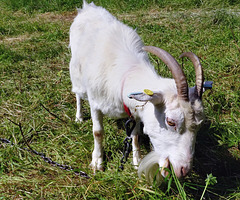Phil's photos with the keyword: Domestic animals
Playmates.
| 30 Jul 2017 |
|
|
|
Photographed near Ball Grove park in Colne, North-West England. In this field were a number of horses and two donkeys.....the two in this photograph were chasing each other around the field and seemed to be having a great time playing together. Photographed with a Sony RX100 compact camera and processed with Nikon Capture NX2 software.
.
Smile please.
| 20 Jul 2015 |
|
|
|
Photographed on farmland near Burnley, North-West England. This was taken with an "ultra-wide" Samyang 10mm manual-focus lens from a distance of about 1 foot.....the horse appears to be smiling although he / she was actually trying to eat the camera.
Camera: Nikon D300s
Lens: Samyang 10mm f2.8
Processed with Nikon Capture NX2
Why the long face?
| 21 Jun 2015 |
|
|
|
A close-up portrait photographed from a distance of approximately 1 foot / 0.3 mtrs using a Samyang "super-wide" 10mm manual-focus lens. Camera Nikon D300s and processed with Nikon Capture NX2.
Poser.
| 08 Jun 2015 |
|
|
|
A "lens testing shot", photographed in Barrowford, Pendle district, Lancashire. I only bought this lens the previous day and wasn't familiar with the controls & handling. Also, I hadn't used this camera (body) for a long time so I unintentionally took a whole series of shots with the aperture set at f2.8.....the results in this case, however, were very pleasing.
Camera Nikon D300s. Lens Nikkor 17-55mm f2.8 DX.
Here's looking at you, kid (HFF).
| 08 Jun 2015 |
|
|
|
A close-up test shot with my new lens photographed in a field next to the cemetery in Barrowford, Lancashire. The lens (hood) wouldn't fit through the fence and the horse wouldn't keep still but I think the result is probably better than the way I had originally intended. Title from the film "Casablanca".
Camera Nikon D300s. Lens Nikkor 17-55mm f2.8 DX.
Miniature pony (2 of 2).
| 12 Nov 2014 |
|
|
|
Another view (see previous photo) of a miniature Shetland pony photographed on a small farm near Burnley, Lancashire, in the North-West of England. These animals are not much bigger than a large dog such as an Alsatian (A.K.A. "German shepherd"). Photographed with a Sony RX100 compact camera and processed with Nikon Capture NX2 software.
Miniature pony (1 of 2).
| 09 Nov 2014 |
|
|
|
A miniature Shetland pony photographed on a small farm near Burnley, Lancashire, in the North-West of England. These animals are not much bigger than a large dog such as an Alsatian / German shepherd.....the fence here, for comparison, was only about 4 feet high (1.2 metres). Photographed with a Sony RX100 compact camera and processed with Nikon Capture NX2 software.
Feed me !!
| 19 Oct 2014 |
|
|
|
A miniature Shetland pony photographed at a small farm near Burnley, Lancashire, in the North-West of England. As we walked past, he / she was standing motionless, staring into his / her empty food bucket and turning alternatively between us and the bucket as if to say "Please feed me".
Photographed with a Sony RX100 compact camera and processed with Nikon Capture NX2 software.
Friends.
| 15 Oct 2014 |
|
|
|
Horses photographed near Burnley in the North-West of England using a Sony RX100 compact camera. Processed with Nikon Capture NX2.
Dressed to impress.
| 15 Oct 2014 |
|
|
|
Photographed between Brierfield and Burnley in Lancashire, North-West England. I was actually trying to photograph some other horses (see next photo) in the same field but this one kept following me along the fence and obscuring my view of them.
Camera: Sony RX100.
Processed with Nikon Capture NX2.
English Longhorn.
| 09 Oct 2014 |
|
|
|
English Longhorn cattle are a long-horned brown and white breed of beef cattle originating from the Craven area in the North-West of England. The breed was initially used as a draught animal which its body is well suited for; the milk was also collected for butter and cheese because of its high butterfat content. An individual farmer would have owned one or two cows; these would have been accompanied by a bull owned by the Lord of the Manor. The long, curved horns that serve to distinguish this breed from others can make an individual appear aggressive, although by temperament they are usually friendly. Longhorns live surprisingly longer than other breeds of cattle and are also known for calving with ease. They have a white patch along the line of their spine and under their bellies. They are not to be confused with the Texas longhorn breed which is also often called "Longhorn cattle" or "Longhorns".
Though long-horned oxen were already predominant in Craven in the 16th and 17th centuries, the English Longhorn breed was much improved for beef by Robert Bakewell of Dishley when large amounts of meat were needed to feed people who had moved to towns and cities in the Industrial Revolution. His selective breeding made the "Dishley Longhorn" very popular towards the end of the 18th century. The breed is still to be found in Leicestershire at the Stanley's Springbarrow Farm, Freddie de Lisle's Quenby Hall and a small herd has been re-introduced at Calke Abbey in Derbyshire where the Harpur-Crewe family had traditionally kept them.
(Wikipedia).
English Longhorn cattle.
| 06 Oct 2014 |
|
|
|
English Longhorn cattle are a long-horned brown and white breed of beef cattle originating from the Craven area in the North-West of England. The breed was initially used as a draught animal which its body is well suited for; the milk was also collected for butter and cheese because of its high butterfat content. An individual farmer would have owned one or two cows; these would have been accompanied by a bull owned by the Lord of the Manor. The long, curved horns that serve to distinguish this breed from others can make an individual appear aggressive, although by temperament they are usually friendly. Longhorns live surprisingly longer than other breeds of cattle and are also known for calving with ease. They have a white patch along the line of their spine and under their bellies. They are not to be confused with the Texas longhorn breed which is also often called "Longhorn cattle" or "Longhorns".
Though long-horned oxen were already predominant in Craven in the 16th and 17th centuries, the English Longhorn breed was much improved for beef by Robert Bakewell of Dishley when large amounts of meat were needed to feed people who had moved to towns and cities in the Industrial Revolution. His selective breeding made the "Dishley Longhorn" very popular towards the end of the 18th century. The breed is still to be found in Leicestershire at the Stanley's Springbarrow Farm, Freddie de Lisle's Quenby Hall and a small herd has been re-introduced at Calke Abbey in Derbyshire where the Harpur-Crewe family had traditionally kept them.
(Wikipedia).
Up close and personal.
| 04 Oct 2014 |
|
|
|
Photographed between the Pendleside villages of Barley and Roughlee in Lancashire, North-West England. I don't know what breed this cow is (any ideas?).....there were two adults with two young calves in the field and this one followed me along the fence-line, keeping herself between me and the young ones she was protecting. I wanted to get a close-up of the calves but in the end I had to give up....I wasn't going to argue with those horns !!
Update....I've just been informed that these are English Longhorn cattle.
Camera: Sony RX100.
Processed with Nikon Capture NX2.
Posing for the camera.
| 08 Jul 2014 |
|
|
|
The domestic goat (Capra aegagrus hircus) is a subspecies of goat domesticated from the wild goat of southwest Asia and Eastern Europe. The goat is a member of the family Bovidae and is closely related to the sheep as both are in the goat-antelope subfamily Caprinae. There are over 300 distinct breeds of goat; they are one of the oldest domesticated species and have been used for their milk, meat, hair, and skins over much of the world. Goats are among the earliest animals domesticated by humans. The most recent genetic analysis confirms the archaeological evidence that the wild Bezoar ibex of the Zagros Mountains (Iran) are the likely origin of almost all domestic goats today.
Neolithic farmers began to herd wild goats for easy access to milk and meat, primarily, as well as for their dung which was used as fuel and their bones, hair, and sinew for clothing, building, and tools. The earliest remnants of domesticated goats dating 10,000 years before present are found in Ganj Dareh in Iran. Goat remains have been found at archaeological sites in Jericho, Djeitun and Çayönü, dating the domestication of goats in Western Asia at between 8000 and 9000 years ago. Studies of DNA evidence suggests 10,000 years ago as the domestication date. Historically, goat hide has been used for water and wine bottles in both travelling and transporting wine for sale. It has also been used to produce parchment.
(Wikipedia).
Camera: Sony RX100. Processed with Nikon Capture NX2 software.
My four-legged friend.
| 21 Jun 2014 |
|
|
|
Photographed in a field near Brierfield, North-West England, using a Sony RX100 compact camera and processed with Nikon Capture NX2. This was taken from close range and I think she was trying to decide whether or not my camera was edible. Goats will eat (or try to eat) almost anything !!
"Bearded Lady".
| 19 Jun 2014 |
|
|
|
We found this "nanny" goat (and 3 others) tethered on a long chain in a field during a walk to Raven's Clough Wood yesterday. She was very nervous at first but I managed to "bribe" her with some juicy grass which was out of her reach and eventually I was able to get within touching distance and take a few close-up photos. The "bleep" of the camera focussing startled her at first but the fresh grass proved too good to resist !
Photographed with a Sony RX100 compact camera and processed with Nikon Capture NX2.
King of the hill.
| 06 Feb 2014 |
|
|
|
One from my archives....a shot of a young bullock taken with my first digital SLR near the village of Roughlee in Pendle district, North-West England. In the distance is Blacko Tower, a well-known local Victorian "folly". Processed with Nikon Capture NX2 software.
"Old Horny".
| 26 Jan 2014 |
|
|
|
Photographed near the village of Newchurch in Pendle, North-West England, using a Nikon D90 camera and AF-S DX VR Zoom-Nikkor 18-105mm f/3.5-5.6G ED lens. One of my first photos with this camera and the "kit" lens.
Jump to top
RSS feed- Phil's latest photos with "Domestic animals" - Photos
- ipernity © 2007-2025
- Help & Contact
|
Club news
|
About ipernity
|
History |
ipernity Club & Prices |
Guide of good conduct
Donate | Group guidelines | Privacy policy | Terms of use | Statutes | In memoria -
Facebook
Twitter










